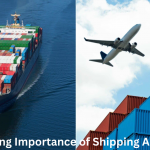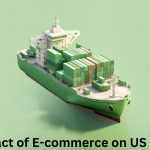Shipping is a critical element of global trade, and with the rapid rise of e-commerce, it has become an indispensable part of modern business operations. However, as companies navigate a highly competitive marketplace, one significant challenge looms large: the high cost of shipping. These costs not only affect profit margins for businesses but also impact consumer purchasing behavior, leading to heightened expectations for fast, free, or low-cost delivery.
In this article, we will explore the factors contributing to the high cost of shipping, the effects on businesses and consumers, and potential solutions for reducing these costs without compromising the quality of service.
Factors Contributing to the High Cost of Shipping
Several factors influence shipping costs, from the complexity of logistics to the rising demands of e-commerce. Here are the primary drivers behind high shipping expenses:
1. Fuel Costs
Fuel prices are one of the most significant contributors to high shipping costs. Shipping companies, whether they operate trucks, planes, or ships, are heavily reliant on fuel, and fluctuations in fuel prices directly impact shipping rates. When fuel costs rise, carriers often pass these expenses onto businesses, increasing the cost of delivery.
2. Last-Mile Delivery
The final leg of the shipping journey, known as last-mile delivery, is often the most expensive and inefficient part of the process. Delivering individual packages to customers’ doorsteps, particularly in densely populated urban areas or remote locations, requires substantial resources, time, and coordination. Traffic congestion, frequent stops, and customer-specific delivery requirements all add to the complexity and cost of last-mile delivery.
3. Rising Consumer Expectations
The “Amazon Effect” has revolutionized consumer expectations regarding shipping. Amazon’s introduction of fast, free two-day shipping has set a new standard, forcing other retailers to offer similar services to stay competitive. The demand for expedited shipping puts pressure on businesses to absorb additional costs, especially when customers expect free or low-cost delivery as a given.
4. Labor Shortages
Labor shortages in the shipping and logistics industry have further driven up costs. Warehouse workers, drivers, and other essential personnel are in short supply, and companies are increasingly offering higher wages and benefits to attract and retain staff. This increase in labor costs ultimately gets passed on to consumers in the form of higher shipping rates.
5. Packaging and Dimensional Weight Pricing
Carriers calculate shipping costs based not only on the actual weight of a package but also on its dimensions, a practice known as dimensional weight pricing. Large, lightweight packages can incur higher fees because they take up more space in delivery trucks or cargo planes, even if they don’t weigh much. This pricing model is a major contributor to increased shipping costs, especially for businesses shipping bulky but lightweight items.
6. Customs, Duties, and International Shipping
For businesses engaged in international trade, additional costs arise from customs, duties, and taxes. These fees vary depending on the destination country and the type of goods being shipped. The process of clearing customs can also add time and complexity to international shipping, further driving up costs.
7. Environmental Sustainability
As consumer demand for sustainable and eco-friendly business practices grows, many companies are investing in greener shipping methods. These include the use of electric vehicles, carbon-neutral shipping options, and eco-friendly packaging. While these measures are crucial for reducing the environmental impact of shipping, they often come at a higher cost, particularly during the initial stages of implementation.
The Impact of High Shipping Costs on Businesses
The high cost of shipping presents several challenges for businesses, particularly in industries where profit margins are thin. Here are some of the key impacts:
1. Reduced Profit Margins
For businesses that offer free or low-cost shipping to attract customers, the rising costs of shipping can erode profit margins. While customers may appreciate the convenience of free shipping, businesses must absorb these expenses, which can result in reduced profitability. Small businesses, in particular, often struggle to balance competitive shipping offers with maintaining healthy margins.
2. Increased Product Prices
To offset shipping costs, some businesses increase the price of their products. While this strategy can help cover delivery expenses, it risks alienating price-sensitive customers who may turn to competitors offering lower prices or free shipping. This can make it difficult for businesses to remain competitive in a crowded marketplace.
3. Pressure on E-commerce Growth
E-commerce businesses, which are heavily reliant on shipping, are particularly vulnerable to the high cost of shipping. Rising shipping rates can deter online sales, as customers may abandon their shopping carts at checkout when faced with high shipping fees. Additionally, businesses that rely on global supply chains must factor in the added expense of international shipping and customs duties, which can limit their ability to expand into new markets.
4. Operational Strain
Managing shipping logistics, especially during peak seasons, places operational strain on businesses. High shipping costs force companies to carefully manage inventory, warehouse space, and order fulfillment processes to keep expenses under control. The pressure to deliver products quickly while keeping costs low can lead to operational inefficiencies, further complicating the shipping process.
The Consumer Perspective on Shipping Costs
Consumers are increasingly accustomed to the convenience of free or discounted shipping, making it challenging for businesses to charge full shipping fees without negatively affecting customer satisfaction. Here are some of the ways high shipping costs impact consumer behavior:
1. Cart Abandonment
One of the most significant consequences of high shipping fees is cart abandonment. Studies show that unexpected shipping costs at checkout are one of the main reasons customers abandon their online shopping carts. When faced with steep shipping fees, consumers may opt to shop elsewhere or delay their purchase.
2. Preference for Free Shipping
Consumers consistently prioritize free shipping over fast shipping. In many cases, customers are willing to wait longer for their packages if it means avoiding shipping fees. This has prompted many businesses to offer free shipping on orders that meet a certain minimum threshold, encouraging customers to spend more to qualify for the free shipping option.
3. Loyalty to Retailers Offering Free Shipping
Retailers that offer free shipping, even if the costs are built into the price of the product, tend to build greater customer loyalty. Customers view free shipping as a value-added service, and businesses that offer it are more likely to see repeat purchases. However, the challenge lies in balancing the perceived benefit of free shipping with the reality of higher product prices.
Strategies for Reducing Shipping Costs
Despite the many challenges posed by high shipping costs, there are several strategies businesses can adopt to reduce these expenses and remain competitive:
1. Negotiate with Carriers
Shipping carriers often offer discounted rates for businesses that ship high volumes of packages. By negotiating with carriers or using third-party logistics providers, businesses can secure more favorable shipping rates, especially if they commit to long-term contracts or consolidate shipments.
2. Use Shipping Software
Shipping management software can help businesses compare rates across multiple carriers, automatically selecting the most cost-effective option for each shipment. These tools can also streamline the process of generating shipping labels, tracking packages, and managing returns, improving overall efficiency.
3. Optimize Packaging
Minimizing packaging size and weight can lead to significant cost savings, particularly when dealing with dimensional weight pricing. Businesses should invest in custom packaging solutions that reduce excess space and unnecessary materials.
4. Offer Free Shipping with Minimum Spend
To maintain profitability while offering free shipping, many businesses set a minimum order value that customers must reach to qualify for free shipping. This encourages larger purchases while offsetting shipping expenses.
5. Outsource Fulfillment
For businesses struggling with high operational costs related to shipping, outsourcing fulfillment to third-party logistics (3PL) providers can reduce overhead. 3PL providers handle everything from warehousing to shipping, often at a lower cost than maintaining in-house operations.
Conclusion
The high cost of shipping is a growing challenge for businesses in today’s e-commerce-driven world. From rising fuel prices to labor shortages and complex last-mile delivery logistics, these expenses can quickly add up, impacting profit margins and customer satisfaction. However, by understanding the factors contributing to these costs and implementing strategies such as negotiating rates, optimizing packaging, and offering free shipping strategically, businesses can mitigate the financial impact of shipping and maintain a competitive edge in the marketplace.
FAQs
1. How do fuel prices affect shipping costs?
Fuel prices are a major driver of shipping costs. When fuel prices rise, shipping carriers like FedEx, UPS, and DHL incur higher expenses to operate their delivery trucks, planes, and ships. These carriers typically pass the extra fuel cost onto businesses and consumers through fuel surcharges.
2. What is last-mile delivery, and why is it so expensive?
Last-mile delivery refers to the final stage of the shipping process, where goods are delivered directly to the customer’s address. It is often the most expensive and complicated part of the shipping journey because it involves multiple stops, traffic congestion, and customer-specific requirements. Last-mile delivery is resource-intensive, especially in densely populated cities or rural areas, leading to higher costs.
3. Why do dimensional weight and packaging impact shipping costs?
Shipping carriers often use dimensional weight pricing, which calculates shipping costs based on the size of the package rather than its actual weight. This is because large but lightweight packages take up more space in delivery vehicles. To reduce costs, businesses should optimize their packaging to minimize excess space and unnecessary materials.
4. How does labor shortage in the logistics industry impact shipping costs?
Labor shortages, particularly for truck drivers and warehouse workers, have increased labor costs in the logistics industry. To attract and retain workers, companies are raising wages, which leads to higher overall shipping costs for businesses and consumers. The shortage also creates delays in fulfillment, further driving up costs.
5. How do customs and duties affect international shipping costs?
When shipping internationally, businesses must account for customs fees, duties, and taxes imposed by the destination country. These charges vary depending on the type of goods, their value, and the country of origin. The process of clearing customs also adds complexity and time, contributing to higher costs for international shipping.




